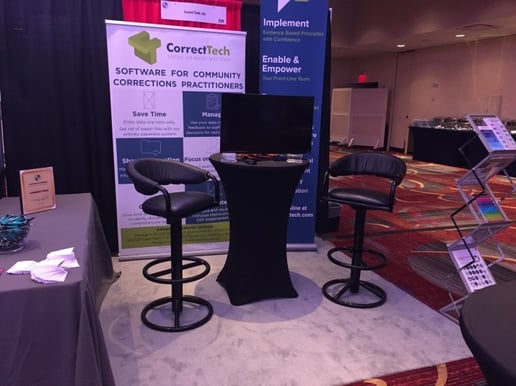
Our reflections of APPA 2017 from the inside, outside and beyond.
Last month we found ourselves positioned in a good space as we went about setting up our booth at APPA’s 42nd Annual Training Institute, held this year in a particularly exciting place, New York City. We were positioned on the Expo floor at a busy nexus of booths and buffet tables, and our team reconnected with and met practitioners from all over the country. Each brought their knowledge, progressive nature and passion for EBP. We attended several interesting sessions as well, which highlighted important challenges facing the corrections industry.
The Big Apple proved the perfect backdrop for APPA, and we explored some of the city’s unique places. Following are a few highlights from inside the conference, activities outside it, and challenges going forward.
Inside:
Conference Kickoff
Keynote speaker and best-selling Orange Is the New Black author, Piper Kerman, reflected on her own “harsh and difficult” space -- a minimum-security prison where she served 13 months for money laundering and drug trafficking. Her confinement infiltrated her mental, physical and emotional well-being, yet on leaving this space, she said she was surprised to find her community re-entry so challenging. Moving out of confinement and into supervision put her in limbo, that tricky no man’s land between lockup and freedom where life happens, but you’re still being watched as you make plans.
Implementation Leadership
Glenn Tapia (Colorado Division of Criminal Justice) and Brandon Matthews (Colorado State Board of Parole) took their place at the podium to present “Ten Essential Principles of Implementation Leadership.” They spoke of how vital trust and gumption are in the transformation to implementation, and in real world practice, we must move toward a place of being “relentlessly optimistic” if we are to petition fidelity and promote EBP. They acknowledged that it’s human nature for change to be exhilarating when done by us and exhausting when done to us, so we must “disrupt people at a rate they can absorb.” If we are to “aim high and miss the mark in lieu of aiming low and hitting it,” we need to navigate out of our comfort zone and push forward. Implementation requires changes in values and beliefs, more intention, experimentation and discovery, and for these practices to take place across an organization.
Client-Centered Focus
LA County’s Probation Department shared their County’s challenges, discoveries and treatment approaches. Dave Mitchell, Dalia Alcantara and Janica Jones reported that several client-centered changes have positively impacted their juvenile offenders, and noted where these kids are held and housed makes a measurable difference. Last year a committee was formed to participate in a grant to reduce isolation, and Healing Opportunities and Positive Engagement (HOPE) Centers emerged. The County works to avoid putting kids in confinement and maintains post-adjudicated kids in camp organizations. The goal is to move juveniles back to the general population where vital services are, like counseling and school. The heartbreaking irony is many kids who need services the most are the ones who receive the least.
Accurate reporting and documentation are critical for assessments, incident reports, and mental health referrals, and this data can result in a change of housing, a chance for improvement. The County also has experimented with envisioning their spaces differently, and for relatively minimal cost they’ve changed the environment in some of their “hang out” centers. The presenters shared slides showing now colorful walls, ample group seating and activity areas where once were drab environs, limited seating and nothing to do. The kids in these newer centers spend far less time in confinement, if at all. The juvenile population brings a higher level of treatment needs, and reforms are needed with school related offenses.
Outside:
We enjoyed getting out and exploring Manhattan, the city that never sleeps. Below are a few highlights:
- A visit to the 9/11 Memorial and Museum was both profound and enlightening. The resilience of this city, the resolve of its people and the compassion extended to so many are inspiring, and the story and the space were beautifully orchestrated and revealed.
- Our hotel’s rotating 48th floor lounge – New York’s only revolving rooftop restaurant -- offered a relaxing view of Times Square and beyond, and a unique way to see the city while enjoying a cocktail.
- Like the millions of residents here, New York pizza comes in all shapes and sizes. We sampled many, many variations and ALL were delicious!
- Exploring this city’s always colorful streets on foot best showcases its spirit and energy; there is no place like New York!
Beyond:
Data Driven, Human Run
Data remains an important part of continuing to progress, evaluate and implement EBP. Technical assistance, strategic reform programs and smart legislation all contribute to the success of these efforts. Programs working on implementing risk assessments are useful in monitoring the risk level and help guide the level of supervision needed. However, these programs cannot replace the role of human supervision. Lock up doesn’t have to mean locking down emotionally for these people, who are people first and foremost.
The corrections industry finds itself at a pivotal place. Many organizations are on the cusp of making changes to increase efficiency and minimize confusion. We talked with several probation officers and practitioners who admitted they were unsatisfied with their current software platform, yet felt stuck in a place with little control to improve their data collection, management and utility. They reported that often data is entered, but the knowledge and ability to extract it is lacking. Intelligent platforms, diligent implementation and education are key in moving toward a current, efficient and effective place. The practitioner focus should be on what matters, because at the end of the day, our work is about people supporting people.


